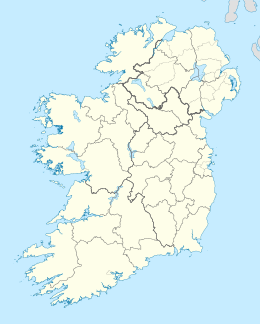Inishmore
| Native name: Árainn Mhór | |
|---|---|

A view over the karst landscape on Inishmore from Dún Aonghasa
|
|
| Geography | |
| Location | Atlantic Ocean |
| Coordinates | 53°07′25″N 9°43′39″W / 53.12361°N 9.72750°WCoordinates: 53°07′25″N 9°43′39″W / 53.12361°N 9.72750°W |
| Area | 31 km2 (12 sq mi) |
| Length | 14 km (8.7 mi) |
| Width | 3.8 km (2.36 mi) |
| Administration | |
| Province | Connacht |
| County | Galway |
| Demographics | |
| Population | 845 (2011) |
Inis Mór (Irish: Árainn [Irish pronunciation: [ˈɑːɾən̠ʲ]] ![]() listen , Irish: Árainn Mhór or Irish: Inis Mór) is the largest of the Aran Islands in Galway Bay in Ireland and has an area of 31 km2 (12 sq mi). Inishmore has a population of about 840, making it the largest of the Aran Islands in terms of population and largest island off the Irish coast with no bridge or causeway to the mainland. The island is famous for its strong Irish culture, loyalty to the Irish language, and a wealth of Pre-Christian and Christian ancient sites including Dún Aengus, described as "the most magnificent barbaric monument in Europe" by George Petrie.
listen , Irish: Árainn Mhór or Irish: Inis Mór) is the largest of the Aran Islands in Galway Bay in Ireland and has an area of 31 km2 (12 sq mi). Inishmore has a population of about 840, making it the largest of the Aran Islands in terms of population and largest island off the Irish coast with no bridge or causeway to the mainland. The island is famous for its strong Irish culture, loyalty to the Irish language, and a wealth of Pre-Christian and Christian ancient sites including Dún Aengus, described as "the most magnificent barbaric monument in Europe" by George Petrie.
Prior to the 20th century, the island was more commonly called Inis Bant or as Árainn na Naomh. The modern Irish name, Árainn Mhór, (which translates as "Great Aran" in English) leads to some confusion with Arranmore, County Donegal. The Irish word Árainn means "long ridge", presumably referring to the island's geography. Árainn is the legal placename in Irish or English as declared in the Official Languages Act 2003.
...
Wikipedia

